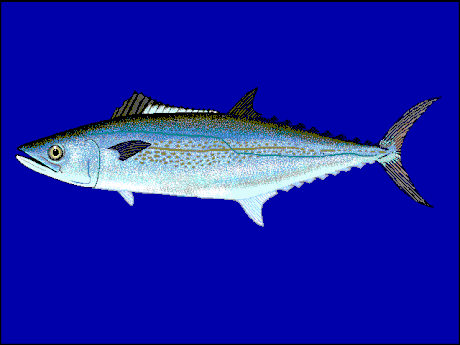Scomberomorini is a tribe of ray-finned saltwater bony fishes that is commonly known as the Spanish mackerels, seerfishes or seer fish. This tribe is a subset of the mackerel family (Scombridae) – a family that it shares with three sister tribes, the tunas, mackerels, and bonitos, and the butterfly kingfish. Scomberomorini comprises 21 species across three genera.[1] They are pelagic fish, fast swimmers and predatory in nature, that fight vigorously when caught. They are mainly caught using hooks and lines.
| Spanish mackerels | |
|---|---|
 | |
| Cero mackerel, Scomberomorus regalis | |
| Scientific classification | |
| Domain: | Eukaryota |
| Kingdom: | Animalia |
| Phylum: | Chordata |
| Class: | Actinopterygii |
| Order: | Istiophoriformes |
| Family: | Scombridae |
| Subfamily: | Scombrinae |
| Tribe: | Scomberomorini Starks, 1910 |
| Genera | |
| |
Taxonomy
The following cladogram shows the most likely evolutionary relationships between the Spanish mackerels and the tunas, mackerels, bonitos, and the butterfly kingfish.
| The Spanish mackerels, in the family Scombridae | |||||||||
| |||||||||
| Cladogram showing the relationship of the tribe Scomberomorini with the rest of the family Scombridae.[2][3] |
This tribe comprises 21 species in three genera:
- Acanthocybium (Gill, 1862)
- A. solandri (Cuvier, 1832), wahoo
- Grammatorcynus (Gill, 1862)
- G. bicarinatus (Quoy & Gaimard, 1825), shark mackerel
- G. bilineatus (Rüppell, 1836), double-lined mackerel
- Scomberomorus (Lacepède, 1801)
- S. brasiliensis Collette, Russo & Zavala-Camin, 1978, Serra Spanish mackerel
- S. cavalla (Cuvier, 1829), king mackerel
- S. commerson (Lacépède, 1800), narrow-barred Spanish mackerel
- S. concolor (Lockington, 1879), Monterrey Spanish mackerel
- S. guttatus (Bloch & Schneider, 1801), Indo-Pacific king mackerel
- S. koreanus (Kishinouye, 1915), Korean seerfish
- S. lineolatus (Cuvier, 1829), streaked seerfish
- S. maculatus (Mitchill, 1815), Atlantic Spanish mackerel
- S. multiradiatus Munro, 1964, Papuan seerfish
- S. munroi Collette & Russo, 1980, Australian spotted mackerel
- S. niphonius (Cuvier, 1832), Japanese Spanish mackerel
- S. plurilineatus Fourmanoir, 1966, Kanadi kingfish
- S. queenslandicus Munro, 1943, Queensland school mackerel
- S. regalis (Bloch, 1793), Cero mackerel
- S. semifasciatus (Macleay, 1883), broadbarred king mackerel
- S. sierra Jordan & Starks, 1895, Pacific sierra
- S. sinensis (Lacépède, 1800), Chinese seerfish
- S. tritor (Cuvier, 1832), West African Spanish mackerel
In India
Spanish mackerel is very much liked for its delicacy in various regions of South India and Sri Lanka. In Andhra Pradesh and Tamil Nadu, this fish is called Vanjaram and is usually the most expensive fish available. In Kerala, it is called Neymeen. It is called Aiykoora in northern Kerala and south coastal Karnataka. In Sri Lanka, Spanish mackerel is known as thora. Seerfishes are also referred to as king mackerels in some areas. They have very sharp teeth and are handled with care by fishers familiar with them. Seerfish is one of the more popular in this group for eating. Seerfishes are notorious for their histamine poisoning. It can be fried, grilled, and steamed. It is gaining popularity in the South Pacific and United States as a canned product.
Throughout India, Spanish mackerel may be known as the following:
- Tamil - Vanjaram, Seela
- Telugu - Vanjaram Chepa
- Kannada - Konema, Kalagnani, Surmai
- Tulu - Anjal
- Malayalam - Neymeen, Aiykoora
- Sinhala (Sri Lanka) - Thora
- Marathi - Surmai
- Konkani - Iswon
See also
References
Wikiwand in your browser!
Seamless Wikipedia browsing. On steroids.
Every time you click a link to Wikipedia, Wiktionary or Wikiquote in your browser's search results, it will show the modern Wikiwand interface.
Wikiwand extension is a five stars, simple, with minimum permission required to keep your browsing private, safe and transparent.
